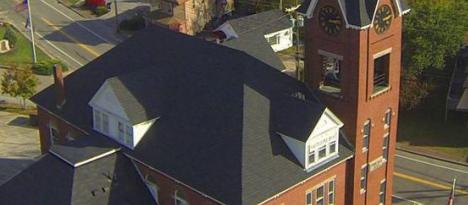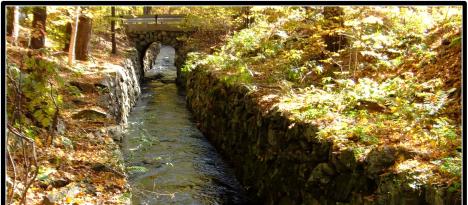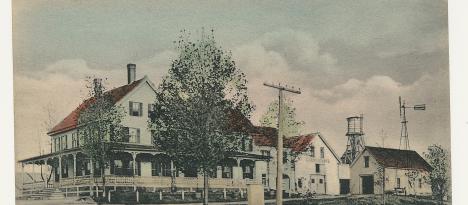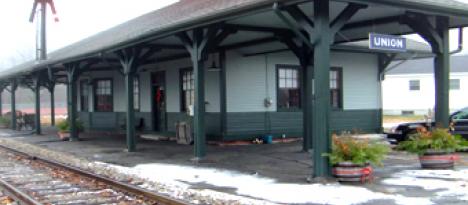About Our Town
Wakefield was chartered in 1749 when the Masonian Proprietors conveyed 79 one hundred acre parcels to investors from Somersworth, Dover and Kittery. Many of these men never settled here but sold off smaller lots to individuals who did. According to the terms of the grant, 40 families had to be settled within five years of the end of the French & Indian War and seven years later a meeting house was to be provided and preaching maintained. Six acres was set aside on the shore of what is now Lovell Lake for the meetinghouse, a school, a training ground and a burial ground. In 1771 the frame for the first meetinghouse was raised on this parcel near the outlet of Lovewell’s Pond. There is a marker in what is now Lovell Lake Cemetery denoting this site. In this building, plans for the Revolutionary War were formulated, and voting for the democracy and for George Washington occurred.
Industry in Wakefield began soon after the settlement in 1767. The first known mills, Wakefield’s first grist and sawmills, were established by David Copp near the headwaters of Lovewell’s Pond near today’s Town Beach.
On August 30, 1774 a petition was presented by several local residents to Governor John Wentworth and the Town of Wakefield was incorporated. In those early days it was the responsibility of the Town fathers to look after the spiritual as well as the material welfare of the Townspeople. In 1785, Asa Piper, a graduate of Harvard, was hired as pastor and continued to serve until his death in 1835.Usually the minister was the most highly educated man in Town but not so in Wakefield. Education was funded by the Town in 1776 and a school committee was established. Rev. Piper established the first circulating library in Wakefield and Brookfield. Ultimately there were 12 school districts. It is believed that the degree of higher education promoted here led to many residents, male and female, that attended college in the 1800’s and early 1900’s.
By 1789, there were 7 mills in town. All were positioned to harness water power from the many streams, rivers and outlets of our lakes and ponds.
Wakefield offered abundant timber in its vast forested landscape. Hard and soft woods were harvested and milled for the manufacture of boards, shingles, boxes, excelsior and other products. (Note: the exhibit at the Heritage Centre that depicts these mills). The environment, ecology and natural setting of Wakefield were conducive to agriculture, settlement and industry. Water features provided the setting for mill construction; local timber and stone were used to construct dams and mills. Local forests were harvested for lumber and wood products.
At the same time, the area known as Wakefield Corner was becoming a busy place. With six stagecoach lines merging here, several inns and taverns were built to accommodate the traveler. Most residences and other buildings here were built between 1770 and 1816. Business thrived and town activities were carried on here. After the arrival of the railroad in Sanbornville in 1871, this changed. In 1895 the current Town Hall in Sanbornville was built and Town offices and meetings were held here.
While growth occurred in Wakefield Corner, other areas of town were also changing. Small village areas grew by the lakes and streams. First sawmills were built to saw logs for home construction, then gristmills for grinding corn, wheat and oats. Over time more industrial operations were established. These villages: Union, Sanbornville, Wakefield Corner, South Wakefield, East Wakefield (Woodman and Burleyville), and North Wakefield comprise what we know as Wakefield.
In 1854 the Eastern Railroad reached the village of Union, as this was the terminus of the railroad. For the next seventeen years, Union became a hub of activity. Farmers brought their goods to Union to be shipped to Boston and beyond. Peddlers, suppliers and stage lines left Union on a regular basis. The inns, liveries, blacksmith shops and mills were busy. This continued until 1871 when the railroad was extended north to Sanbornville. The following year the railroad was extended to Conway and to Wolfeboro. With this expansion Sanbornville (then called Wolfeborough Junction) became a large center for railroad activity. The village of Wolfeborough Junction owes its very existence to the Hon. John W. Sanborn. He laid out the wild land into lots, built the Sanborn House and other buildings, secured the erection of the railroad shops and gave inducements to business men to locate here. Three additional railroad stations were built: Wakefield Corner, East Wakefield and North Wakefield. Rail was the expedient way to transport goods and travelers.
By 1892 Boston and Maine purchased the rail line further encouraging growth in Sanbornville and this area became an important rail center. Two ice companies purchased 1000 feet of frontage on Lovell Lake and began harvesting ice with 16 to 20 train carloads heading to Boston and beyond daily. In April 1911 a fire destroyed much of the rail yard and buildings. The rail center moved to Dover. With the coming of electrification the need for ice diminished. The popularity of the automobile also further reduced the need for rail travel.
In addition to the railroad, the many lakes and stream in Wakefield played a large part in the economic growth. Our natural resources and rural character continued to attract many summer visitors. Throughout most of the 20 th century waterfront development was Wakefield’s primary industry. The construction of these summer homes and the services needed provided incomes for many of Wakefield’s residents.
As the popularity of the automobile increased, a nationwide roadway system was built. Rail was no longer the preferred transportation mode. Rt. 16 was built which bisected through the villages of Union, Sanbornville, Wakefield Corner and North Wakefield. Along this route, overnight cabins, teahouses, general stores and gas stations were established adding seasonal income to the residents. In the mid 1950’s, with the relocation of Rt16 to the western edge of Wakefield, these were bypassed. Because of this, the rural character of the villages has been retained.
By the end of the 1980’s most of the waterfront property had been developed into seasonal or year round homes. As the cost of owning a vacation home increased, we now see the second home population replaced with the many permanent waterfront homes we see today.
Pam Wiggin, Chair
Wakefield Heritage Commission







